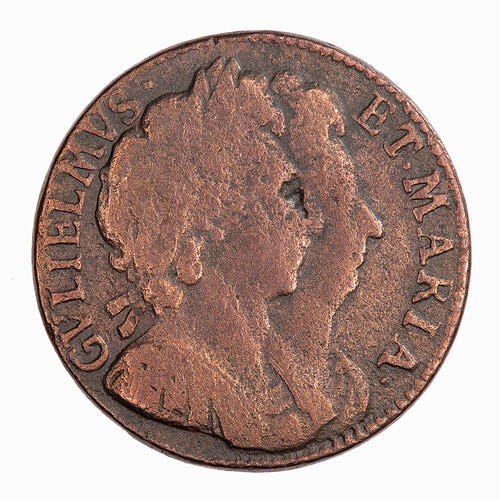Summary
Copper coin: Denomination: Farthing
King William III and Queen Mary II (1688-1694)
Mary was the daughter of James II. For reasons of politics she had married William of Orange, James II nephew and left England to live with him in the Netherlands. When James II lost support, William was invited to invade England and to take over the throne jointly with his wife. James II escaped to France and live there in exile until his death. William and Mary are both depicted on the obverse of their coins, William insisted that he take precedence so his bust superimposes on hers.
On 17 April 1694 the British House of Commons resolved to issue halfpence and farthings in English copper (earlier copper coins were made from imported Swedish copper), replacing the tin pieces introduced under Charles II. A licence was issued for their production to Sir Joseph Herne, Sir Francis Parry, George Clark, Abel Stanley and Daniel Barton to manufacture 700 tons of coins within the next seven years.
A farthing is a 1/4 penny.
Obverse Description
Conjoined busts of William (laureate) and Mary facing right; around, GVLIELMVS ET MARIA
Reverse Description
Britannia seated facing left holding a spear and an olive branch, her left arm rests on a shield decorated with the combined crosses of St. George and St. Andrew; around, BRITANNIA in exergue, 1694
Edge Description
Plain
More Information
-
Collecting Areas
-
Acquisition Information
Transfer from Melbourne Branch of Royal Mint, 11 Jan 1978
-
Date Issued
1694 AD
-
Issued By
-
Issued By
-
Denomination
-
Series
-
Material
Copper
-
Axis
06
-
Classification
-
Category
-
Discipline
-
Type of item
-
Overall Dimensions
22 mm (Outside Diameter), 4.748 g (Weight)
-
Shape
Round
-
References
[Book] Skingley, Philip. 2007. Coins of England and the United Kingdom., Spink 3453 Pages


